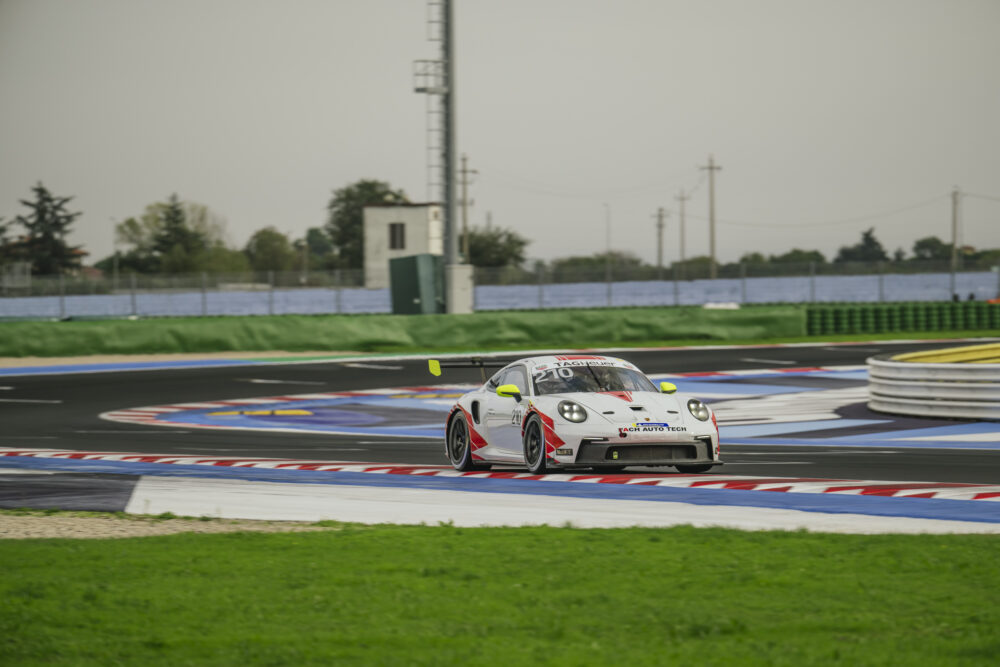Porsche: 700 hp and flying rubber 🎥
FASCINATION RACE CIRCUIT As part of the Porsche Sports Cup Suisse, AutoSprintCH had the opportunity to do some fast laps behind racing pro and Porsche factory driver Richard Lietz on the Circuit Misano. In the video, Richard Lietz demonstrated how to drive the Porsche 911 GT2 RS cleanly on the racing line. Even the affiche raised the pulse: With 700 [...]
Richard Lietz demonstrated in the video how to drive the Porsche 911 GT2 RS cleanly on the racing line.
Even the affiche raised the pulse: with 700 hp, semislicks and rear-wheel drive on the racetrack, in free practice in a pack of around 30 cars - all chasing the best lap times.
Then came reality in Misano: In pit 10, where the team from the Porsche Center Zug prepares and looks after the vehicles, it was a case of "helmet on, adjust seat and steering wheel position, start engine".
The warning of the teacher
I know that the six-cylinder boxer of the GT2 RS, which is now still bubbling away harmlessly, will soon be ready to unleash up to 750 Newton meters on the rear wheels, and at 7,000 revs 700 horsepower will finally be given free rein.

"We're taking it slow," reassures Richard Lietz, who is a race driver, instructor and private tutor for three journalists here in Misano. "You have to be careful with the pickup, the tire wear, which sticks to the ground in large quantities on this track and is picked up again by the rounds."
Finally out on the slopes
As suspected, the "slow start" is not so slow at all. But right behind the experienced pro, the pace picks up lap after lap. It's a matter of following the racing line set by the driver in front as closely as possible, sounding out the right braking points - and being considerate of the other vehicles that are milling around the circuit during free practice. It's reassuring to know that with the GT2 RS we have significantly more turbo power available than the many GT3 models, whose high-revving naturally aspirated engine delivers around 500 hp.

Drum concert from tire abrasion
I quickly remember Richard's words of warning: The pickup plays an important role on the 4226-meter-long Circuit Marco Simoncelli, which is interspersed with 16 curves. If too much of the rubber stuff sticks to the front wheels, there's a risk of understeer. Too much collected rubber on the rear wheels reduces traction and could lead to a spin. However, the tires can be quickly freed from the pickup by clever line selection - here we again benefit from Profi Lietz.
But the pickup material that lies on the ground is not only stuck to the tire, it is also swirled into the air. This results in real drum concerts of rubber crumbs in the wheel arches of our cars. In addition, the "black spätzle" keep flying at the front hood and on the apron. There they leave nasty stains - as our "traces of work", so to speak.

Another experience from my fast Misano excursion: riding a circuit not only requires the highest level of concentration at all times, but also a great deal of stamina. Non-professionals soon start to show signs of fatigue. Then it's time for a pit stop - and a strong Italian espresso.
Training with the pros
"We had quite a bit of speed," Richard records at the end of our Misano experience. That's nice to hear from a racing pro who won the FIA World Endurance Cup in 2015 as the best GT driver in the Porsche 911 RSR, is a multiple Le Mans, Daytona, and Nürburgring winner, and also has plenty of rally experience.
And by the way: Interested parties can be introduced to racing practice under competent guidance as part of the Porsche Track Experience. With 100-percent supervision, Porsche professionals test talent and aptitude as a race driver for a week. However, an investment of around 50,000 euros is required for this intensive training course with lots of theory and practice.










